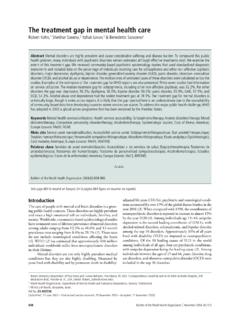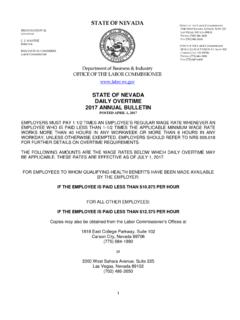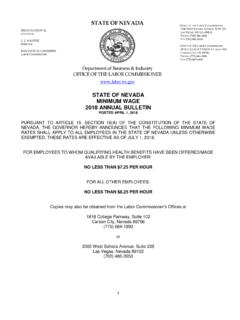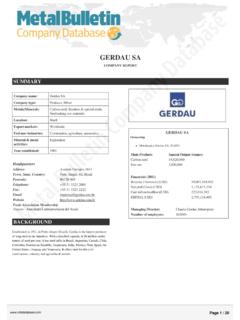Transcription of The cost of diabetes in Latin America and the …
1 The cost of diabetes in Latin America and the CaribbeanAlberto Barcelo ,1 Cristian Aedo,2 Swapnil Rajpathak,3& Sylvia Robles4 ObjectiveTo measure the economic burden associated with diabetes mellitus in Latin America and the estimates of diabetes for the year 2000 were used to calculated direct and indirect costs of diabetes costs included costs due to drugs, hospitalizations, consultations and management of complications. The human capitalapproach was used to calculate indirect costs and included calculations of forgone earnings due to premature mortality and disabilityattributed to diabetes mellitus.
2 Mortality and disability attributed to causes other than diabetes were subtracted from estimates toconsider only the excess burden due to diabetes . A 3% discount rate was used to convert future earnings to current annual number of deaths in 2000 caused by diabetes mellitus was estimated at 339 035. This represented a loss of757 096 discounted years of productive life among persons younger than 65 years (>US$ 3 billion). Permanent disability caused a lossof 12 699 087 years and over US$ 50 billion, and temporary disability caused a loss of 136 701 years in the working population andover US$ 763 million.
3 Costs associated with insulin and oral medications were US$ 4720 million, hospitalizations US$ 1012 million,consultations US$ 2508 million and care for complications US$ 2 480 million. The total annual cost associated with diabetes wasestimated as US$ 65 216 million (direct US$ 10 721; indirect US$ 54 496).ConclusionDespite limitations of the data, diabetes imposes a high economic burden to individuals and society in all countries and toLatin American and the caribbean as mellitus/economics/complications; Cost of illness; Health care costs; Disabled persons; Value of life//economics; Latin America ; caribbean region (source: MeSH, NLM).
4 Mots cle sDiabe` te/e conomie/complication; Cou t maladie; Cou t soins me dicaux; Handicape ; Valeur de la vie/e conomie; Ame riquelatine; Cara bes (source: MeSH, INSERM).Palabras claveDiabetes mellitus/econom a/complicaciones; Costo de la enfermedad; Costos de la atencio n en salud; Personasincapacitadas; Valor de la vida/econom a; Ame rica Latina; Regio n del Caribe (fuente: DeCS, BIREME).Bulletin of the World Health Organization 2003;81 page 25 le re sume en franc ais. En la pa gina 26 figura un resumen en espan mellitus presents a high burden for individuals andsociety.
5 This burden is not only related to health care costs, butalso to indirect costs caused by loss of productivity fromdisability and premature mortality. Medical expenditures forpeople with diabetes are 2 3 times higher than for those notaffected by diabetes (1). In Latin America and the caribbean ,many people with diabetes have limited access to health care,which means that indirect costs may exceed direct health care of diabetes and other noncommunicable diseasespresents a challenge for most health care systems in LatinAmerica and the caribbean .
6 Some countries in the region arefacing an increasing prevalence of diabetes and other non-communicable diseases, while still experiencing a high incidenceof communicable diseases. diabetes is a chronic disease thatrequires lifelong, continuous medical care. Health care services indeveloping countries are oriented to acute medical careThis cost-of-illness study aimed to estimate the economicburden of diabetes in Latin America and the caribbean in report presents a societal perspective of the cost ofdiabetes. Calculations included indirect costs due to prematuremortality, absenteeism and disability, as well as direct costsattributed to drugs, consultations and all the calculations in this study, we used Amos et al.
7 Sprevalence estimates for 2000 (2). We used the distribution byage from a recent diabetes survey in Bolivia to break down thetotal population with diabetes into age groups (3). Adistribution of countries based on per capita gross nationalproduct (GNP) values was used to classify the countries intofour groups (Table 1) (4).Costs for different items related to medical care forpeople with diabetes were obtained for one or two countries ineach group from various sources, such as the government, PanAmerican Health Organization (PAHO) and diabetes associa-tions.
8 When more than one estimate was available for one itemin the same country, we calculated an average of the cost(Table 2). We assumed that costs for different items weresimilar within each country group. A 3% discount rate was usedto convert future earnings to current Adviser, Program on Non-Communicable Diseases, Division of Disease Prevention and Control, Pan American Health Organization, Regional Office of theWorld Health Organization, 525 23rd Street NW, Washington DC 20037, USA (email: Correspondence should be addressed to this , Universidad Alberto Hurtado, Assistant, Pan American Health Organization, Washington, DC, Coordinator, Program on Non-Communicable Diseases, Pan American Health Organization, Washington, DC, of the World Health Organization 2003, 81 (1)Direct total number of persons taking insulin wascalculated as the estimated number of people with type 1diabetes plus 5% of people with type 2 diabetes .)
9 We assumedan annual use of 10 000 IU (27 IU per day) for each persontaking insulin (5). The commercial cost of insulin was obtainedfrom two or three countries in each assumed that 80% of the totalpopulation with type 2 diabetes used oral drugs. We estimatedthe number of tablets taken as 1500 per year per person (5).Consultations and hospitalizationsResearch from Costa Rica showed that people with diabetesmade times more medical visits and had timesmore hospitalizations than people without diabetes (6). Thenumbers of medical visits and hospitalization per inhabitantsin each country were multiplied by factors of and ,respectively, which represented the fractions of excess visitsand hospitalizations due to diabetes (6, 7).
10 The estimatednumber of people with diabetes was then multiplied by theseproducts. In the case of hospitalizations, we obtained thetotal number of hospital days by multiplying the number bythe average of length of stay in each country (7). The studyin Costa Rica also reported an increased length of stay forpeople with diabetes ; the reported length of stay from eachcountry was increased accordingly. The costs of consulta-tions and per-day hospitalization were obtained from thegroup of prevalences of major complications were estimated from asurvey that included 8100 people with diabetes who attendedclinics and hospitals in Chile (8).

















